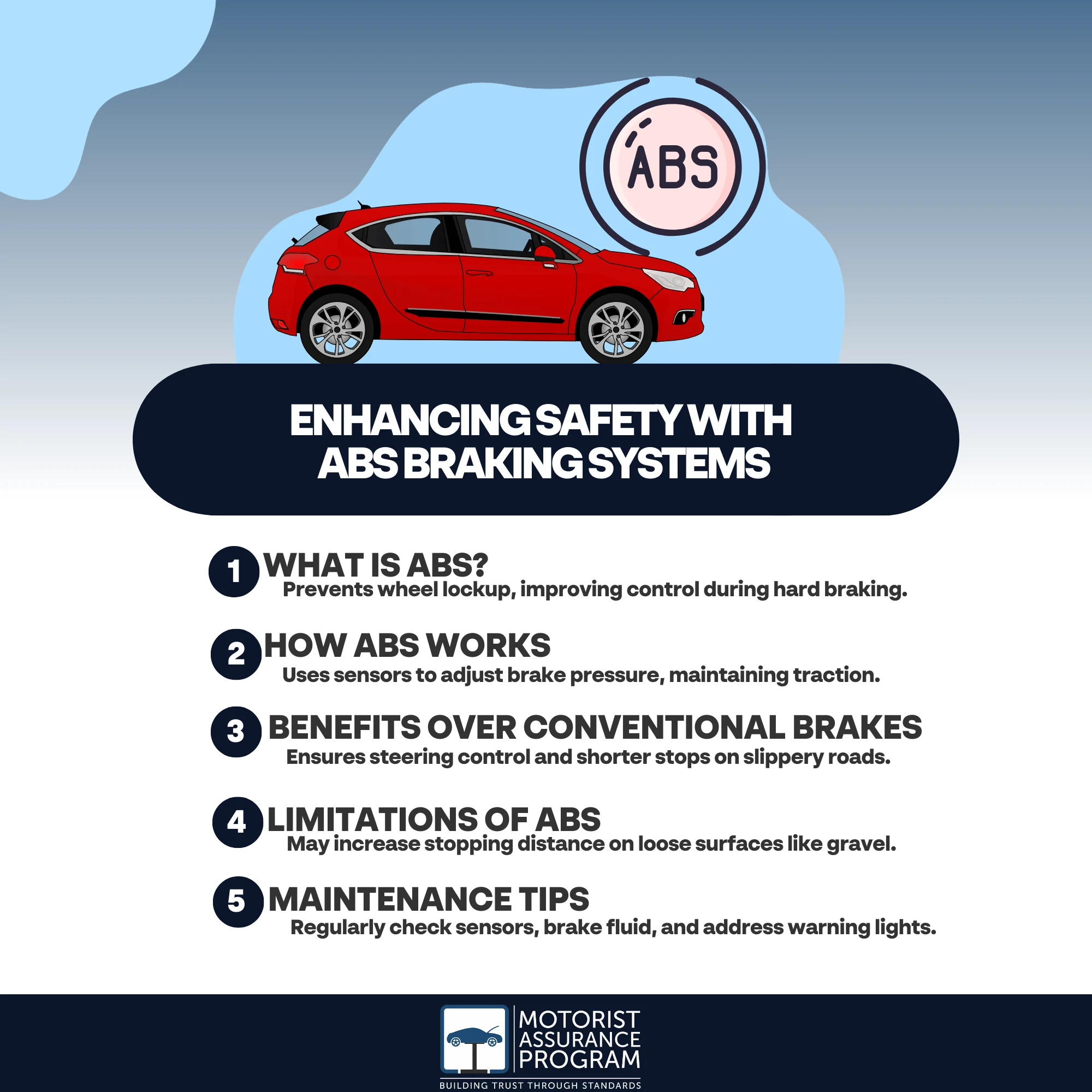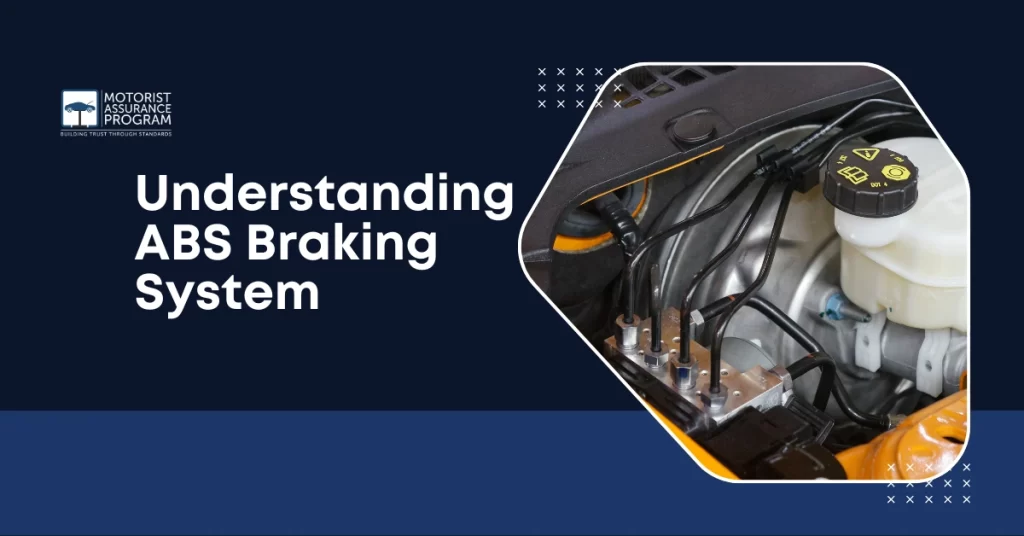ABS, or Anti-lock Braking System, prevents your wheels from locking up during hard braking, thereby securing safety and control. It utilizes wheel speed sensors to monitor rotation, adjusting brake pressure through a hydraulic control unit to maintain traction. Unlike conventional brakes, which can lead to skidding, ABS allows you to steer effectively in emergencies. However, it’s crucial to apply firm pressure on the brake pedal, as pumping won’t engage the system. While ABS notably improves stability, it might not shorten stopping distances on certain surfaces. Understanding its operation can improve your driving performance and safety in adverse conditions.

Key Takeaways
- ABS stands for Anti-lock Braking System, designed to prevent wheel lockup during hard braking for enhanced vehicle control.
- It uses wheel speed sensors and a hydraulic control unit to modulate brake pressure, maintaining traction and steering.
- Unlike conventional brakes, ABS allows for steady pressure on the brake pedal, improving performance on slippery surfaces.
- While ABS improves safety, it may not reduce stopping distances on all surfaces, like gravel or ice.
- Understanding how to use ABS effectively—by applying firm and continuous pressure—can improve overall driving safety.
WHAT IS ABS?
What exactly is ABS? ABS stands for Anti-lock Braking System, a vital technology in modern vehicles designed to increase safety during emergency braking situations. At its core, ABS braking is an antilock braking system (ABS) prevents the wheels from locking up during hard braking, which can lead to skidding and loss of control.
An antilock braking system is composed of several key components, including wheel speed sensors, a control module, and hydraulic brake actuators. These elements work in unison to monitor the speed of each wheel, allowing the system to detect when a wheel is about to lock up. When this occurs, ABS rapidly adjusts brake pressure, releasing it momentarily before reapplying it, thereby maintaining traction and steering control.
This technology not only shortens stopping distances on slippery surfaces but also enables drivers to maintain directional control while braking. Understanding what ABS braking is and how it functions is vital for anyone looking to improve their vehicle’s safety features.
Ultimately, ABS is a fundamental component for modern driving, contributing greatly to accident prevention.
HOW DOES ABS WORK?
ABS operates through a sophisticated interaction between its components to prevent wheel lockup during braking. When you apply the brakes, the anti-lock braking system (ABS) monitors the rotational speed of each wheel using speed sensors. If it detects that a wheel is about to lock up—typically when braking hard—the system immediately reduces brake pressure to that wheel. This modulation occurs rapidly, often several times per second, ensuring maximum traction.
So, how does ABS work? The core of the ABS braking system consists of a hydraulic control unit that adjusts the brake pressure based on the feedback from the wheel speed sensors. When you brake, the system assesses the conditions and decides whether to maintain or decrease pressure. This prevents the wheels from skidding, allowing you to retain steering control during emergency stops.
The antilock braking system definition hinges on this ability to prevent wheel lockup, providing safer braking performance on various surfaces. By understanding these mechanics, you can better appreciate how ABS maximizes vehicle control and stability, especially in adverse conditions.
ARE ANTI-LOCK BRAKES DIFFERENT FROM CONVENTIONAL BRAKES?
Many drivers might wonder how anti-lock brakes differ from conventional braking systems. An antilock braking system (ABS) enhances your control during hard braking, while conventional brakes may lead to wheel lockup.
Here’s a breakdown of the key differences:
- Functionality: The anti-lock braking system (ABS) uses sensors to monitor wheel speed, preventing lockup and allowing steering control.
- Braking Technique: With ABS, you can apply steady pressure on the brake pedal, while conventional systems require pumping the brakes to avoid skidding.
- Performance in Various Conditions: ABS performs better on slippery surfaces, helping maintain traction, whereas conventional brakes can lose grip and lead to longer stopping distances.
- Driver Intervention: An antilock braking system (ABS) allows you to maintain vehicle control during emergency stops, while conventional brakes may demand more driver skill and attention to avoid accidents.
WHAT ARE THE LIMITATIONS OF ABS BRAKES?
While anti-lock braking systems (ABS) offer significant advantages over conventional brakes, they do have limitations that drivers should be aware of. One major limitation is that ABS doesn’t necessarily reduce stopping distance on all surfaces. On loose gravel or ice, you may find that traditional braking techniques yield better results. This is because ABS can allow the wheels to slip slightly, which might not provide the ideal grip needed on these surfaces.
Drivers also often misunderstand how to engage ABS effectively. In an emergency situation, you should brake firmly and maintain pressure on the pedal. It’s crucial not to pump the brakes, as doing so can render the antilock braking system (ABS) ineffective. You need to trust that the system will modulate the brakes for you.
If your vehicle does not have ABS, use threshold braking, where you apply the brakes just short of locking the wheels. Understanding these limitations of ABS brakes can reinforce your safety and driving performance. Being aware of how to react in various conditions is vital for effective vehicle control.
Frequently Asked Questions
How Do I Know if My ABS Is Functioning Properly?
To know if your ABS is functioning properly, check for the ABS warning light on your dashboard. Also, listen for unusual noises during braking, and test your vehicle’s braking stability in slippery conditions.
Can ABS Cause Longer Stopping Distances on Certain Surfaces?
When rubber meets the road, ABS can actually lead to longer stopping distances on certain surfaces, like ice or gravel. It prevents wheel lock-up, which may reduce traction in those specific conditions.
What Should I Do if My ABS Warning Light Is On?
If your ABS warning light is on, you should check your vehicle’s manual for guidance, inspect the brake fluid level, and visit a qualified mechanic immediately to diagnose and resolve any underlying issues.
Does ABS Work in All Weather Conditions?
ABS functions like a steady hand during a storm, maintaining control in various weather conditions. However, its effectiveness can diminish on icy or snow-covered roads, so always drive cautiously and adapt your speed accordingly.
How Can I Maintain My ABS System?
To maintain your ABS system, regularly check brake fluid levels, inspect sensors for dirt or damage, make certain electrical connections are secure, and schedule professional inspections to address any warning lights or system irregularities promptly.
Conclusion
In conclusion, understanding ABS braking systems heighten your driving safety and control. Vehicles equipped with ABS can reduce stopping distances by up to 30% on slippery surfaces compared to those without. This statistic illustrates how vital ABS technology is, especially in emergency situations where every inch counts. By recognizing its operation and limitations, you can navigate challenging conditions with greater confidence, ensuring you’re better prepared for the unexpected on the road.


